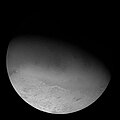Triton Hopper
 Artist's concept of the Triton Hopper | |
| Mission type | Reconnaissance |
|---|---|
| Operator | NASA |
| Spacecraft properties | |
| Spacecraft type | Robotic |
| Dry mass | 500 kg[1] |
| Triton lander | |

Triton Hopper is a proposed NASA lander to Triton, the largest moon of Neptune.[2] The idea is to harvest the abundant nitrogen ice on the surface of Triton and use it as propellant for multiple short flights and explore a variety of locations. The concept transitioned in March 2018 to Phase II to refine their designs and explore aspects of implementing the new technology.
History
[edit]Triton is the largest moon of Neptune. In 1989, Voyager 2 flew past the moon at a distance of 40,000 km,[3] and discovered several cryovolcanoes on its surface. Triton is geologically active; its surface is young and has relatively few impact craters. It has a very thin atmosphere.
The Triton Hopper concept started Phase I in 2015, and it transitioned in March 2018 to Phase II, where the new technologies are being matured by NASA's Institute for Advanced Concepts (NIAC).[4][5]
Overview
[edit]The Triton Hopper concept proposes the use of a radioisotope rocket engine that would collect nitrogen ice on or below the surface, heat it under pressure and use it as propellant to explore Neptune's moon Triton.[5][6] The largest technological challenge is to learn how to mine local surface nitrogen ice, and how to heat it for use as propellant.[5] The rocket-powered hops are estimated to be up to 1 km high and 5 km long.[7][8]
A rocket-powered vehicle, or "hopper", has several advantages due to the variety of terrain and a gravity of only 8% of that of Earth. Hemispheric traverses and atmospheric sampling are possible during hops.[2]
While airborne, the craft could acquire images and videos during flight. While on the ground, it could photograph and analyze the chemistry and geology of the surface. It could potentially fly through geysers on Triton's surface to analyze the material ejected from them.[9]
See also
[edit]- Comet Hopper
- Europa Lander (NASA)
- Trident, a flyby proposal to Triton
- Pluto Hop, Skip, and Jump, a very similar proposal
References
[edit]- ^ Iannotta, Ben (13 January 2017). "NASA's Far-Out Space Concepts". American Institute of Aeronautics and Astronautics. Archived from the original on 29 September 2017. Retrieved 29 September 2017.
- ^ a b Steven Oleson (7 May 2015). "Triton Hopper: Exploring Neptune's Captured Kuiper Belt Object". NASA Glenn Research Center. Retrieved 11 February 2017.
- ^ Gray, D (1989). "Voyager 2 Neptune navigation results". Astrodynamics Conference: 108. doi:10.2514/6.1990-2876.
- ^ Triton Hopper: Exploring Neptune's Captured Kuiper Belt Object. Steven Oleson, NASA Glenn Research Center. 30 March 2018.
- ^ a b c Ferreira, Becky (August 28, 2015). "Why We Should Use This Jumping Robot to Explore Neptune". Vice Motherboard. Retrieved 11 February 2017.
- ^ Machado-Rodriguez, Jonathan; Landis, Geoffrey A. (2017). "Analysis of a Radioisotope Thermal Rocket Engine". 55th AIAA Aerospace Sciences Meeting. doi:10.2514/6.2017-1445. hdl:2060/20170006624. ISBN 978-1-62410-447-3.
- ^ Charles Q. Choi (17 May 2016). "This Jumping Probe Might Explore Neptune's Biggest Moon". Popular Science. Archived from the original on 8 November 2020. Retrieved 11 February 2017.
- ^ Oleson, Steven R.; Landis, Geoffrey. "Triton Hopper: Exploring Neptune's Captured Kuiper Belt Object" (PDF). Planetary Science Vision 2050 Workshop 2017.
- ^ Kasprak, Alex (24 June 2016). "A Mission To Neptune's Moon Triton Would Be Pretty Cool". Now.Space. Archived from the original on 2016-06-25. Retrieved 11 February 2017.
External links
[edit]- Exploring Neptune's Captured Kuiper Belt Object, a short NASA video at YouTube

